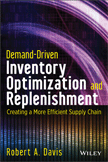Almost since the first commercially viable inventory optimization solutions arrived on the scene in the early 2000s, the industry has been overhyped. It has been amazing to see the number of focuses placed on inventory optimization by various analyst organizations. Just pulling them up on a search engine shows the metamorphosis from a broadly defined space covering everything from network design and constraint theory to the final focuses on inventory policies. Throughout it all many companies, in their search for optimization, simply searched for ways to mimic what they were already doing with this newfangled thing called inventory optimization. Executives who have attempted to explore options are inundated with promises too good to be true and, in most situations shown not to be true.
However, it is too easy to blame the overhyping. Every new software solution process goes through a trough of disillusionment. Visionaries start off the process with proof of value engagements. The software providers cut their installation teeth in places that might not be the best fit, and, over time, word gets out that the promises are not being met. The result ends up being a period of time where inventory optimization starts to fall from the vogue new business opportunity.
Inventory optimization is a viable option for the executive sponsor who understands the business problems he/she is suffering from and why they are leading to mismatched inventories. Inventory optimization is not a technological magic pill! You don’t simply install it and step back expecting miracles. When you just install and step back you get infighting between buyers and management which stop a perfectly good engagements in their tracks. When there is an understanding of what “might” be causing the mismatched inventories objections the organization can overcome the objections and carry on resulting in a fully automated replenishment system powered by inventory optimization!
Simply saying inventory optimization will lower inventories can turn an industry like retail away from ever trying inventory optimization as an augmentation to replenishment planning. They know all about the short-term benefits and long-term disasters put in place by ratcheting down days of supply. However, if inventory optimization is positioned as a way to overcome the documented issue of human nature’s need to overcompensate for perceived supply problems, resulting in the bullwhip effect, you might be on the pathway to a wonderful inventory optimization opportunity.
Demand-driven inventory optimization and replenishment is all about allowing the supply network to function as a synchronized entity to support the customer-facing service level requirements. This is the baseline requirement for any supply chain wanting to move toward a more responsive model. It won’t matter if you have products requiring little customization or products that are almost completely made to order! Demand-driven inventory optimization and replenishment gets your organization focused on the customer.
Inventory optimization requires two distinct pathways of installation. The first is the focus on the technology so the solution is doing what it is set out to do…right sizing the inventory to provide the best possible service level at the lowest possible cost. However, the second pathway might be the most important. Both the software provider and company management need to insure the users of the inventory optimization output understand the overall benefits. The installation of the inventory optimization technology is in no way a reflection of bad performance by buyers or supply chain managers. Indeed, in the vast majority of cases it is quite astonishing how buyers have been able to obtain the high level of efficiencies they have accomplished with outdated speedy replenishment techniques. The thing is speedy replenishment techniques are hard to maintain in a lean inventory environment. Inventory optimization is designed to overcome the gaps in present day systems so the buyer can accomplish much more with far less effort.
 Inventory optimization is a journey from skepticism to acceptance to embracement. The technology part will take care of itself. The users of the output need to have time to fully embrace the results. When inventory optimization is delivered in a two pronged approach…technology and change management…good things happen!
Inventory optimization is a journey from skepticism to acceptance to embracement. The technology part will take care of itself. The users of the output need to have time to fully embrace the results. When inventory optimization is delivered in a two pronged approach…technology and change management…good things happen!
Interested in this topic? Take a look at Robert A. Davis' exciting new book Demand-Driven Inventory Optimization and Replenishment: Creating a More Efficient Supply Chain.

1 Comment
It's weird that so many demand planning experts so often describe skepticism and reluctance on the part of the stakeholders that they try to get involved in the forecasting process (Charles Chase repeatedly described much the same from his experience in Demand Driven Forecasting).
I get the feeling that one of the biggest obstacles demand planners face today is political - in persuading their colleagues that demand planning is worth while... one has to wonder why this is. Is it that the topic is too for many stakeholders to get their heads around and come on board with? Is it that we're trying to sell them solutions that don't give them the answers and the data that they need? It seems like only some of the stakeholders consider the demand driven pill a remedy, whilst many others see it as just a hassle.
A lot could perhaps be done to advance the industry by focusing on this problem, rather than technical issues, which seem to get most of the lime light.